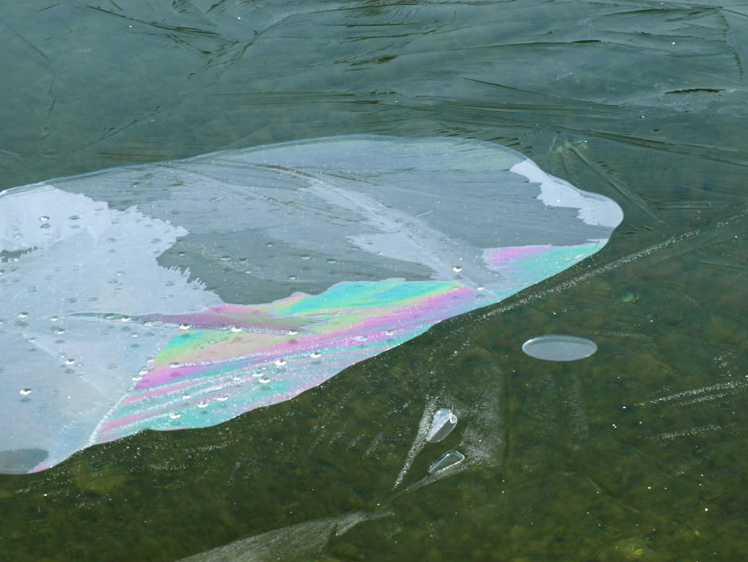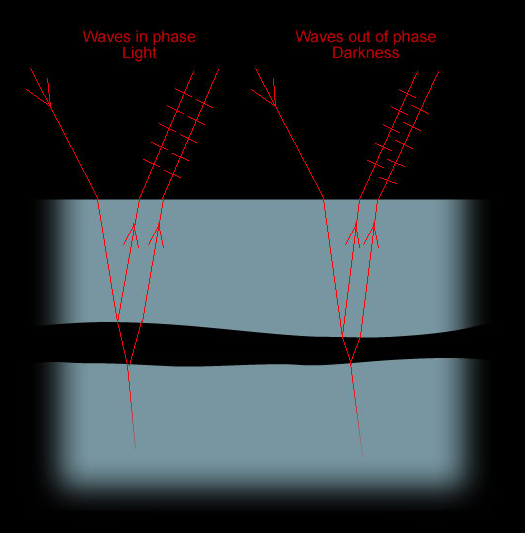Beware of thin ice
Beware of Thin Ice: Exploring the Enchanting Optical Effects on Frozen Lakes
As winter approaches, the Northern Hemisphere becomes a canvas for mesmerizing optical phenomena that unfold on icy ponds and frozen lakes. While the icy terrain may seem barren at first glance, a closer look reveals a world of vibrant colors and shimmering spectacles that can captivate the eye. In this article, we will delve into the fascinating realm of atmospheric optics and explore the enchanting effects that occur on thin ice.
Unveiling Iridescent Colors: A Play of Light and Thin Films
One of the most captivating optical effects observed on icy surfaces is the iridescent display of colors. These ethereal hues, reminiscent of the metallic shades found in soap bubbles and oil films on puddles, are produced through a phenomenon known as thin film interference. When a thin film, such as air or water, is trapped between two layers of ice or within an ice fissure, it acts as a canvas for the play of light waves.
As light waves interact with the thin film, some are reflected upwards within the upper ice layer, while others traverse the thin air or water layer, reflect off the lower surface, and re-enter the upper ice. When the thickness of the air or water layer is just right, the wave paths combine in such a way that certain colors are enhanced while others are darkened. The resulting hues we perceive are intricate mixtures, giving rise to the non-spectral metallic shades that dazzle our senses.
The Dance of Colors: Thin Air vs. Thin Water Films
The captivating interplay of colors on thin ice can arise from various types of thin films. In some cases, it may be air narrowly trapped between two layers of ice or within an ice fissure. Alternatively, a thin film of water can also produce interference colors if its refractive index differs from that of the surrounding material. Let's explore the different sources of color on icy surfaces:
-
Air Films: When air is trapped between ice layers, light waves passing through the upper ice can undergo reflection and refraction at the air-ice interface. As a result, different wavelengths of light interfere constructively or destructively, leading to the manifestation of vivid colors.
-
Water Films: If a thin film of water is present on the ice surface, it can also give rise to interference colors. These colors emerge due to the difference in refractive index between water and ice. As light waves pass through the water film and interact with the ice below, they undergo phase shifts, resulting in a display of captivating hues.
Discovering Nature's Palette: Additional Factors Influencing Ice Colors
While thin films play a significant role in generating the enchanting colors on thin ice, there are other factors that contribute to the overall visual spectacle. Let's take a closer look at these additional influences:
-
Birefringence: Weak birefringence in ice can also contribute to the palette of colors observed on frozen lakes. Birefringence refers to the splitting of light into two polarized components as it passes through a material. This phenomenon can enhance the complexity of colors exhibited by ice.
-
Air Bubbles: Air bubbles trapped within the icy mass can interact with light and cause classical refraction and reflection. These interactions add an extra layer of visual interest to the frozen landscape, creating captivating patterns and hues.
-
Absorption by Ice: Ice itself possesses a subtle bluish hue due to its absorption properties. However, this slight blue color is usually only discernible in crevasses or ice caves, where the ice is thick enough to allow light absorption and transmission through a significant volume of ice.
Exploring Winter's Optical Wonderland
As winter embraces the Northern Hemisphere, venturing onto icy ponds and frozen lakes can reveal an optical wonderland brimming with captivating displays. When approaching these frozen landscapes, it is important to exercise caution and be mindful of the delicate nature of thin ice. While the enchanting colors and patterns may tempt the adventurous spirit, ensuring personal safety should always take precedence.
By understanding the mechanisms behind the optical effects on thin ice, we can appreciate the natural beauty that surrounds us. So, the next time you encounter a frozen lake adorned with shimmering hues, take a moment to marvel at the intricate interplay of light and matter, and embrace the enchantment of atmospheric optics in winter's icy embrace.

Colours in a frozen lake seen by Andrew Kirk. Image �Andrew Kirk, shown with permission.
Now that winter is closing fast on the Northern Hemisphere look for optical effects on icy ponds � don�t fall in!
�The large oval structure is an air bubble, about one meter long. The bubble appears to be trapped between two layers of ice; the smaller bubbles (with their specular highlights) are casting shadows onto the lower ice layer. The iridescence was visible to the naked eye but really popped with a circular polarizer on the camera.�
The iridescent colours are produced by a structural colour effect, thin film interference, the same one that gives us the metallic hues of soap bubbles and of oil films on puddles.
Here the necessary thin film could be air narrowly trapped between two ice layers or an ice fissure. Light waves can be reflected upwards within the upper ice layer. Others leave the ice, traverse the thin air layer, reflect off the lower air/ice surface and enter the upper ice again.
If the air layer is thin enough the two wave paths combine. When the wave crests coincide there is light, when they are completely out of phase there is darkness. The light or darkness condition depends on the film thickness and, importantly, on wavelength. Thus, some colours are enhanced while others are darkened. The final ones we see are always complex mixtures � hence their non-spectral metallic hues.
Another possibility is that the thin film is water trapped in a fissure or between two ice layers. Any thin film of different refractive index to the material bounding it can produce interference colours. More ice colours come from weak birefringence, from classical refraction/reflection by air bubbles trapped within the icy mass and because ice is slightly blue by absorption ~ but you will need a crevasse or ice cave to see that.

Note: this article has been automatically converted from the old site and may not appear as intended. You can find the original article here.
Reference Atmospheric Optics
If you use any of the definitions, information, or data presented on Atmospheric Optics, please copy the link or reference below to properly credit us as the reference source. Thank you!
-
<a href="https://atoptics.co.uk/blog/beware-of-thin-ice/">Beware of thin ice</a>
-
"Beware of thin ice". Atmospheric Optics. Accessed on November 26, 2024. https://atoptics.co.uk/blog/beware-of-thin-ice/.
-
"Beware of thin ice". Atmospheric Optics, https://atoptics.co.uk/blog/beware-of-thin-ice/. Accessed 26 November, 2024
-
Beware of thin ice. Atmospheric Optics. Retrieved from https://atoptics.co.uk/blog/beware-of-thin-ice/.